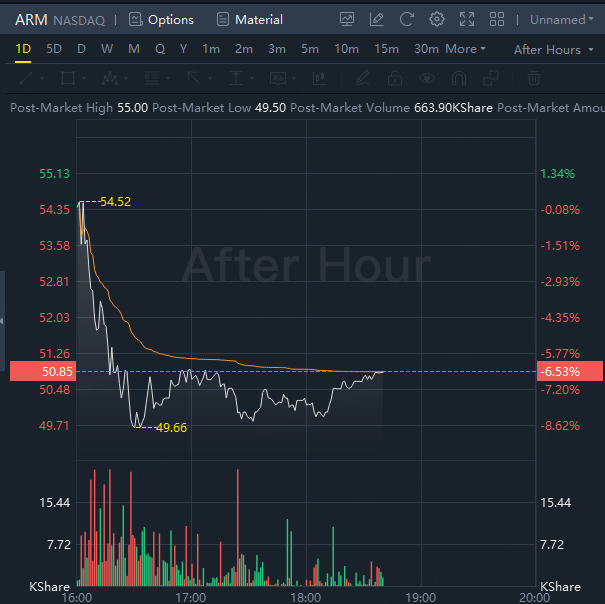Semiconductor company Arm Holdings on Wednesday gave a fiscal third-quarter sales outlook below Wall Street estimates, with the company attributing the forecast to a large deal that will likely land later than expected.
Arm's shares dove nearly 7% in extended trading after the news.
But the company, which sells designs and other intellectual property for creating computing chips that power most of the world's mobile phones, also forecast fiscal full-year sales that beat Wall Street expectations, powered by a wave of companies designing new chips amid a boom in artificial intelligence applications.
Arm became publicly listed again in September after Japan's SoftBank Group, which still owns more than 90% of Arm, sold off some of its shares. One issue that the company is grappling with is new accounting rules that affect how it must recognize revenue from large, multi-year license deals.
In a shareholder letter, Arm's top executives said that "revenue recognition profiles for future agreements are subject to change."
Analysts said that the unpredictability raises questions about Arm's valuation, which, at more than $65 billion after its initial public offering, was far higher relative to its anticipated annual revenue than any other chip company.
"There are still questions about whether there is a sustainable growth narrative for this company," said Ben Bajarin, chief executive and principal analyst at Creative Strategies. "The quarter looked good, but the guidance didn't look good - we don't really understand what the customer cycle looks like."
'STRONG DEMAND'
Arm Chief Financial Officer Jason Child told Reuters that the below-expectations guidance for the current fiscal third quarter but higher full-year forecast was because the company now expects a major licensing deal to land a quarter later than initially expected.
"These are very, very large deals that require lots of complicated approvals that go to the highest levels and it's organizations that can take a while and that's hard for us to predict," Child said in the conference call Wednesday.
Arm said it forecast a fiscal 2024 revenue range with a midpoint of $3.02 billion, above analyst expectations of $2.95 billion, according to data from LSEG. For the current fiscal third quarter, Arm expects a revenue range with a midpoint of $760 million, below analyst estimates of $767.84 million, according to LSEG data.
For Arm's second fiscal quarter ended in September, revenue jumped 28% to $806 million, ahead of an average estimate of $744.31 million, according to LSEG data. Adjusted profit of 36 cents per share beat expectations of 26 cents per share.
Arm has been working to expand from its stronghold of mobile phone chips into other areas such as data center servers and personal computer chips. Reuters last month reported that Nvidia plans to use technology from Arm in a major new challenge to Intel in the personal computer market.
Arm has two primary revenue streams: the upfront licensing fees it charges for access to its chip designs and other intellectual property, and a royalty that it collects on each chip sold that was made with its intellectual property. Arm has said it aims to increase its royalty revenues by moving into parts of the chip market where chips sell for higher average prices.
Arm said that royalty revenue for the fiscal second quarter declined to $418 million, below analyst expectations of $420.3 million, according to data from Visible Alpha. Licensing and other revenue for the second quarter was $388 million, above expectations of $326.9 million, according to data from Visible Alpha.
Child told Reuters that Arm's second quarter royalty revenues still reflected a chip glut that affected the chip industry broadly.
"We expect our royalty numbers to flip to positive (growth) this quarter," Child told Reuters.
It reported a net loss of $509 million in the quarter, driven by employee stock compensation costs. The company said its initial public offering generated a large one-time expense for previously granted shares and that future employee stock compensation costs are expected to be between $150 million to $200 million per quarter.


